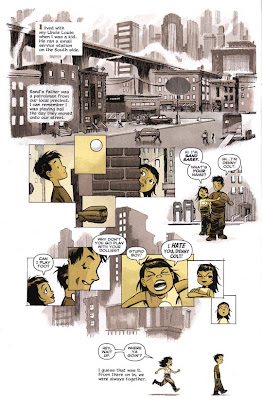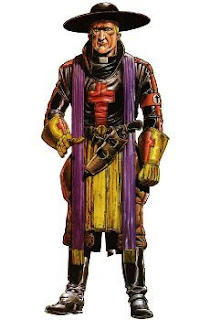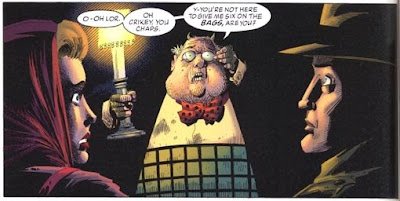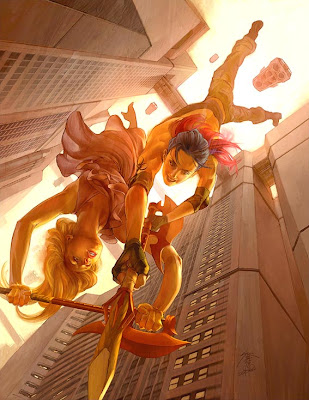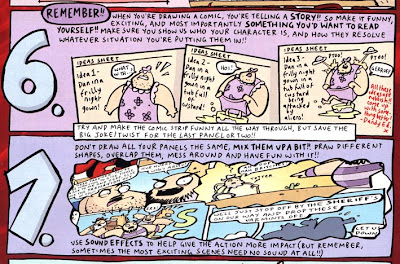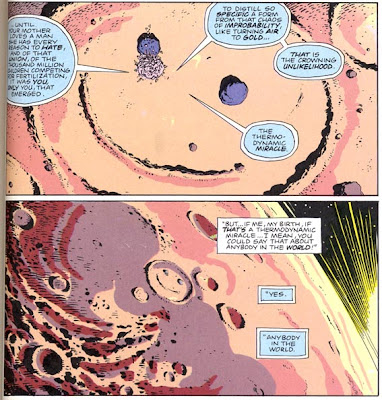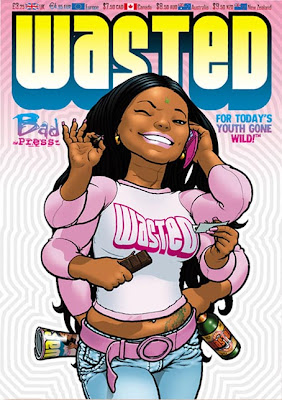Last week was retro week in American comics, or at least it was in those periodicals that I bought.
 Teen Titans Lost Annual
Teen Titans Lost Annual Issue 1 (how many of these do they have lying around?), “President Kennedy Has Been Kidnapped!!” by Bob Haney (writer), Jay Stephens (pencils), Mike Allred (inks), Laura Allred (colours), Gasper Saladino (letters), Dan Raspler & Steve Wacker (editors), cover by Nick Cardy, coloured by Dave Stewart, 48 pages of comics plus 6 pages of sketches by Nick Cardy, US$4.99, DC Comics, March 2008
In 1962, the Teen Titans learn that John F Kennedy has been kidnapped by aliens and brainwashed by them into acting as their war leader.
This story – neither lost nor an annual, but an
Elseworlds special which DC initially decided was unsuitable for publication – was the last comic to be written by Bob Haney before his death in 2004. Haney has become something of a cult figure among comic bloggers, who have mined for humour the preposterous illogicalities of his plots, the inconsistency of his portrayals of characters with those of other writers, and, above all, his clunky attempts to write hipster dialogue. For this special, Haney consciously pastiched himself, playing up those aspects of his old work that have been the target of so much ridicule. In that way, this is his very own
All-Star Batman and Robin the Boy Wonder; only, blessedly, over and done with in one go. There is something dizzying about watching an old man trying to caricature the way that his middle-aged self hoped to write like a teenager for the entertainment of children: all the ages of man in one pamphlet.
Stephens and Allred capture the spirit of 1960s DC art all too well: tasked with drawing such self-consciously absurd ideas as mods in outer space and flying hairy rockers, they give us designs as dull and flat as anything that Curt Swan or Sheldon Moldoff would have produced.

 JLA Classified
JLA Classified Issue 50, “High Frontier: That Was Now, This Is Then” Part 1 by Roger Stern (writer), John Byrne (penciller), Mark Farmer (inker), Rob Clark Jr (letterer), Allen Passalaquia (colourist) and Mike Carlin (editor), cover by Joshua Middleton, 22 pages of comics, US$2.99, DC Comics, Early March 2008
A big, arrogant monster attacks the JLA Watchtower on the Moon and beats everyone up. No, really, that’s all that happens.
More proof that you can’t go home again comes from this story by Roger Stern and John Byrne, which recaptures the style of their work in the early 1980s, before superheroes ate of the fruit of the tree of knowledge proffered by Miller and Moore. A straightforward beat-em-up story, with plodding dialogue in which heroes explain their powers as they use them, characterisation is by thought balloons, and there is even one of those big round-shouldered creatures with which Byrne used to fill the pages of
Alpha Flight and
Superman. But enough decompression has set in to make this more inconsequential than, for example, any of the issues of
Captain America that Stern and Byrne did together. Nothing much happens here: the villain attacks and knocks out most of the League, and J’onn J’onzz thinks he remembers him; and that’s it. Perhaps it will read better when all the parts have been published, but at the moment, this seems like half a 45 RPM record playing at 33 and a third (hey, I can be retro too).

 The Spirit
The Spirit Issue 12, “Sand” by Darwyn Cooke (script, pencils and flashback inks), J Bone (inks), Dave Stewart (colour), Jared K Fletcher (lettering), Ben Abernathy (editor), 22 pages of comics, US$2.99, DC Comics, January 2008
The Spirit meets his long-lost childhood sweetheart, Sand Serif, now a hardened criminal.
Darwyn Cooke bows out of the
Spirit revival with what Will Eisner would have called a “refry” of Eisner’s two-part story from January 1950. That, in itself, was a salvage job on the lead story from Eisner’s abortive comic book,
John Law, Detective, and replacing Law with the Spirit produced a rather unconvincing retcon at the time. Cooke’s story, appearing only 12 issues into the run rather than 502, does less violence to the existing backstory, and the page-to-page and panel-to-panel flow is better than Eisner’s cut-and-paste job. But Eisner realised something that Cooke seems to have ignored. For we readers to care, we must not just be told that Denny Colt loved Sand Serif, we must ourselves see something in her that could justify that love. So Eisner made her an ambivalent character, with a ruthless shell but a conflicted conscience. Cooke makes her hard throughout. A telling example: in both versions of the story, Sand’s associate Dr Vitriol kills a man. In Eisner’s version, Sand deducts $50,000 from Vitriol’s share of the loot “for the widow of the cop you shot last night”. In Cooke’s version, she withholds payment altogether and keeps everything herself because Vitriol’s killing of
Hussein Hussein of Interpol may have “brought down [heat] on us”.
What makes this issue affecting, though, is not so much the story it tells, as a touch Cooke uses in the telling of it. In the flashback sequences, he (and colourist Dave Stewart) beautifully evoke the feel of Eisner’s later works: the fluid, whole-page layouts, the misty cityscapes, the loose strokes of thickly-brushed hatching, and a muted brown colour-scheme to recall the sepia-on-cream printing of
A Contract With God and Other Tenement Stories. This was the way that Eisner looked back on his own life, and it is a fitting way to end a series that could never help recalling him.
